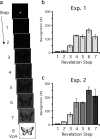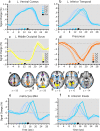Evidence accumulation and the moment of recognition: dissociating perceptual recognition processes using fMRI
- PMID: 17978031
- PMCID: PMC6673371
- DOI: 10.1523/JNEUROSCI.3522-07.2007
Evidence accumulation and the moment of recognition: dissociating perceptual recognition processes using fMRI
Abstract
Decision making can be conceptualized as the culmination of an integrative process in which evidence supporting different response options accumulates gradually over time. We used functional magnetic resonance imaging to investigate brain activity leading up to and during decisions about perceptual object identity. Pictures were revealed gradually and subjects signaled the time of recognition (T(R)) with a button press. We examined the time course of T(R)-dependent activity to determine how brain regions tracked the timing of recognition. In several occipital regions, activity increased primarily as stimulus information increased, suggesting a role in lower-level sensory processing. In inferior temporal, frontal, and parietal regions, a gradual buildup in activity peaking in correspondence with T(R) suggested that these regions participated in the accumulation of evidence supporting object identity. In medial frontal cortex, anterior insula/frontal operculum, and thalamus, activity remained near baseline until T(R), suggesting a relation to the moment of recognition or the decision itself. The findings dissociate neural processes that function in concert during perceptual recognition decisions.
Figures








Similar articles
-
Dissociating early and late error signals in perceptual recognition.J Cogn Neurosci. 2008 Dec;20(12):2211-25. doi: 10.1162/jocn.2008.20155. J Cogn Neurosci. 2008. PMID: 18457507
-
Sensory-motor mechanisms in human parietal cortex underlie arbitrary visual decisions.Nat Neurosci. 2008 Dec;11(12):1446-53. doi: 10.1038/nn.2221. Epub 2008 Nov 9. Nat Neurosci. 2008. PMID: 18997791 Free PMC article.
-
EEG-informed fMRI reveals spatiotemporal characteristics of perceptual decision making.J Neurosci. 2007 Nov 28;27(48):13082-91. doi: 10.1523/JNEUROSCI.3540-07.2007. J Neurosci. 2007. PMID: 18045902 Free PMC article.
-
Dissociating the effect of noise on sensory processing and overall decision difficulty.J Neurosci. 2011 Feb 16;31(7):2663-74. doi: 10.1523/JNEUROSCI.2725-10.2011. J Neurosci. 2011. PMID: 21325535 Free PMC article.
-
Prior expectation modulates the interaction between sensory and prefrontal regions in the human brain.J Neurosci. 2011 Jul 20;31(29):10741-8. doi: 10.1523/JNEUROSCI.1478-11.2011. J Neurosci. 2011. PMID: 21775617 Free PMC article.
Cited by
-
Towards an understanding of parietal mnemonic processes: some conceptual guideposts.Front Integr Neurosci. 2012 Jul 4;6:41. doi: 10.3389/fnint.2012.00041. eCollection 2012. Front Integr Neurosci. 2012. PMID: 22783175 Free PMC article.
-
The functional anatomy of a perceptual decision in the human brain.J Neurophysiol. 2010 Mar;103(3):1179-94. doi: 10.1152/jn.00364.2009. Epub 2009 Dec 23. J Neurophysiol. 2010. PMID: 20032247 Free PMC article.
-
Neural and computational processes of accelerated perceptual awareness and decisions: A 7T fMRI study.Hum Brain Mapp. 2022 Aug 15;43(12):3873-3886. doi: 10.1002/hbm.25889. Epub 2022 Apr 25. Hum Brain Mapp. 2022. PMID: 35470490 Free PMC article.
-
Accumulation System: Distributed Neural Substrates of Perceptual Decision Making Revealed by fMRI Deconvolution.J Neurosci. 2022 Jun 15;42(24):4891-4912. doi: 10.1523/JNEUROSCI.1062-21.2022. Epub 2022 May 12. J Neurosci. 2022. PMID: 35552236 Free PMC article.
-
Domain-general signals in the cingulo-opercular network for visuospatial attention and episodic memory.J Cogn Neurosci. 2014 Mar;26(3):551-68. doi: 10.1162/jocn_a_00504. Epub 2013 Oct 21. J Cogn Neurosci. 2014. PMID: 24144246 Free PMC article.
References
-
- Audley RJ, Pike AR. Some stochastic models of choice. Br J Math Stat Psychol. 1965;18:183–192.
-
- Biederman I. Recognition-by-components: a theory of human image understanding. Psychol Rev. 1987;94:115–147. - PubMed
-
- Botvinick M, Nystrom LE, Fissell K, Carter CS, Cohen JD. Conflict monitoring versus selection-for-action in anterior cingulate cortex. Nature. 1999;402:179–181. - PubMed
-
- Botvinick MM, Braver TS, Barch DM, Carter CS, Cohen JD. Conflict monitoring and cognitive control. Psychol Rev. 2001;108:624–652. - PubMed
MeSH terms
Substances
LinkOut - more resources
Full Text Sources
Medical
